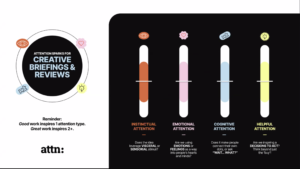“The best story wins,” said Matthew Segal, founder of ATTN:, a digital media company in Los Angeles. “Whoever can tell the best story will stand out in a crowded field.”
His agency specializes in short, attention-grabbing videos for social media. When trying to communicate a message, Segal said, “We don’t have a lot of time, and we can’t count on a captive consumer.”
Segal and colleague Clare Stein, executive creative director at ATTN:, were guest speakers on Sept. for PRSA’s Member Mondays session, hosted by Ray Day, APR, PRSA’s 2025 chair and Stagwell vice chair, and Allison Worldwide executive chair.
Your attention please
To explain how to capture attention in today’s crowded media environment, Stein shared findings from ATTN:’s commissioned research with neuroscientists. The research identifies four kinds of attention: instinctual, emotional, cognitive and helpful. (View the slides here.)
“The first one, instinctual attention, is connected to our evolutionary need to be aware of danger,” Stein said. “A loud sound or a bright color instantly commands attention.”
In social media video, “those first three seconds are incredibly important for viscerally placing [the viewer] in the story,” she said. Capturing attention depends on “how you start it, the visuals, the sound design — they all need to grab people at the very beginning, with the most compelling, interesting, funny, unexpected and surprising part.”
A second type is emotional attention. “When we see another human going through something that we can relate to, we’re pulled in and want to know more about the story,” Stein said.
A close-up image of someone’s face in an emotional moment is a strong way to start a video, she added. “It’s no surprise that the proliferation of creator videos on social media often starts this way, with the person talking close-in to the camera, sharing a vulnerable or funny moment.”
To capture attention, a video “should give the promise of an emotional payoff,” Stein said. “Often we use hooks or headlines in our content that promise the video will make” the viewer feel a certain way by the end. “But they know they have to watch it and experience it in order to get that” payoff.
“When you promise people some kind of emotional feeling in the video, you’re much more likely to hold them,” Segal said.
A third category, cognitive attention, “is my personal favorite,” Stein said. It’s about creating “a curiosity gap. People are more engaged in the story when they have a puzzle to solve, when they’re the ones connecting the dots. They should be able to quickly figure it out, but they feel like they’re in on the story.”
As Segal noted, social media content that holds the viewer’s attention sends algorithmic signals that lead to the video being recommended to other viewers.
A fourth kind is helpful attention, providing people with practical information, such as recipes and how-to guides.
“Think about the value that you bring to the consumer,” Stein said. “And set that up at the beginning.”
Combining two or more types of attention is “when the magic happens,” and the video is more likely to go viral, Segal and Stein said.

Day asked about the best — and the worst — qualities in communications that Stein and Segal see coming from brands and companies today.
“Too many organizations still ask the consumer for their time, and expect the consumer to care or be captive, because they think their issue is important,” Segal said. “They don’t realize that their job is to entertain or engage the consumer.”
As storytellers, he said, “we have to offer the consumer something of value immediately, in pithy and cogent ways.”
Key takeaways from this Member Monday
-
Hook fast. The first three seconds decide if people stay or scroll.
-
Tap into attention types. Stories that tap instinctual, emotional, cognitive or helpful cues are more likely to hold interest..
-
Deliver value immediately. Content must be short, sharp and clearly worth the audience’s time.
Watch a replay of the September 8 session below:
Held on the second Monday of every month, the information-sharing Member Mondays are open to both PRSA members and nonmembers, focusing on topics of interest to the communications profession. There is another session on the fourth Monday of every month for PRSA leaders of Chapters, Districts and Sections, focusing on best-practice sharing and progress on PRSA’s Strategic Plan. Find more information here.
Illustration credit: papisut
The post Member Mondays Recap: Stopping the Scroll With Better Stories first appeared on PRsay.

